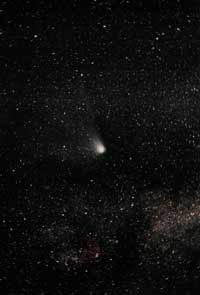Accessible from space
On December 9, 1997, a meteorite struck Greenland with a 10-second earthquake. Although the meteorite reached 4,000 tons, there was nothing. This is not the only example that can be put. For example, on 30 June 1908 the meteorite fell in Siberia, destroying 2,150 square kilometers. The explosion was also noticed thousands of kilometers away. The latter has been the greatest destruction that has come from space in this century, but history is full of similar events.

At present 10,000 asteroids and hundreds of comets are accurately known, although it is estimated that more are not known. Asteroids are rocks. The best known is Ceres, with 1,000 kilometers in diameter. From the telescope they look similar to the stars, as they look like small luminous spots. Being rocks, asteroids do not reflect too much light, so they are difficult to find. On the other hand, comets are not solid masses, but are the water that evaporates as it approaches the sun. The solar system is surrounded by comets and until recently, although they were not very close, they could not be detected. However, although the comets are mostly water, it would be a huge tupusto.
Throughout history, meteorites have acted several times with Earth and the rest of planets and satellites in the solar system. The Earth satellite, the Moon, is a clear example. The Moon has an area of 3,000 kilometers. With a small telescope you can see that the ground of the Moon is full of craters. On the Moon there is no atmosphere or plate tectonics, so there is no erosion, the craters produced by the tupusts of the meteorites are so clearly seen for that. On Earth, erosion has concealed most of the traces of meteor tupuses. Except for exceptions, the most representative crater of three kilometers in Arizona.
Research efforts
Aware of the potential risk, since the beginning of this decade there are two groups that work in NASA itself on this topic: one of them has as objective the detection and cataloging of asteroids and comets that can enter the orbit of the Earth, and the other, the development of technology to change the direction of meteorites. However, since the two working groups mentioned have not received the blessing of the United States Congress, low-budget projects are being worked on. There are also asteroid and comet tracking programs in private laboratories and observatories, and at a much lower level amateur astronomers have a similar project. They also get results. For example, a group of Majorcan astronomers found four new asteroids in 1997.
Although no special interest is perceived by governments, scientists and space agencies try to learn more about comets and asteroids. The first snapshots of a comet were obtained in 1986, when the Giotto probe took pictures of the core of the Halley comet. Years later, in 1993, the Galileo probe sent the first images of the asteroids Gaspra and Ida. The last session of approximation to an asteroid took place last December, when the Near probe was attempted in the orbit of the asteroid Eros. Due to technical problems, the probe failed and failed to enter the orbit of the asteroid Eros. However, when passing very close to the asteroid, with 4,100 kilometers, some data were collected and 1,100 photographs were taken. According to NASA technicians, between August and April 2000 the NEAR probe will enter the orbit of the asteroid again. If it did, for the first time an asteroid could be investigated quite deeply. Like NASA, the European Space Agency (ESA) also wants to travel to a comet in the coming years. For this he has chosen the comet of Wirtan. Taking advantage of the Ariane spacecraft, in 2003 he will send the Rosetta probe to the Wirtan Kite research to collect the samples and send them to the Earth for research.
Do you have defense possibilities?
It may be thought that interest in scientists' asteroids and comets does not come from emptiness. In fact, according to expert simulations, if a kilometer-diameter asteroid hit the Earth the consequences would be much more serious than those of a nuclear explosion.
Is there room for defense? From a technological point of view it seems that yes; if caught over time, there are enough resources on Earth to divert the direction of the stones that can come from space. The problem is the same time, knowing that there is time for those who can come. The closer you get to Earth, the more energy you need to use to change the direction of comets and asteroids, so the chances of success would be lower. Although it has so far been read that the reader could get something else, scientists recognize that the chances of hitting the Earth are small.
Mentions:
Throughout history, meteorites have acted several times with Earth and the rest of planets and satellites in the solar system. The Earth satellite, the Moon, is a clear example.
Taking advantage of the Ariane spacecraft, the European Space Agency will send in 2003 the Rosetta probe to the investigation of the Wirtanen comet for the collection of samples and their shipment to the Earth of research.
Published in 7
Buletina
Bidali zure helbide elektronikoa eta jaso asteroko buletina zure sarrera-ontzian











